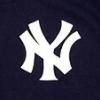-
Posts
21486 -
Joined
-
Days Won
82
Content Type
Profiles
Forums
Downloads
Everything posted by Yankee4Life
-
Next up the 1969 Season which can be downloaded right here. This is another one of the mods that were talked about in this thread that is going to have a little tweaking done to it. But don't think for a second that this in an incomplete mod because it isn't. You'll be going against some good pitching in this mod. For a challenge, try your luck against knuckleballer Phil Niekro of the Braves. Tom Seaver was another dominant pitcher in this season. Here he is facing the Padres. Tommy Agee slides into third with a triple as the throw is wide. Bud Harrelson throws the ball into right field as he attempts to force out the Padre baserunner. Nate Colbert of the Padres. He was the first star of the San Diego franchise. Colbert was a tall first baseman (6'2") but even with his height he could not keep his foot on the bag on this high throw. This ball is just off the glove of first baseman Ed Kranepool.
-
Not at all.
-
1978 continued Cutting off a hit that could have gone for extra bases. Adding to the Mariner lead. Sliding in safely to score. Rick Bosetti makes a nice running catch. He was one of the few bright spots in the early days of the Blue Jay franchise. The ball has just hit the third base bag and bounces up on third baseman Bill Stein. Rick Cerone drops a third strike but is still able to throw out the Mariner batter.
-
Next, the 1978 Season will be featured and that can be downloaded right here. This is another mod that had a recent tweaking and the newest version was uploaded on March 20th. Seattle's Kingdome. The good thing about these mods is that if you really enjoy playing in the Kingdome, you can easily copy the Kingdome in your Mvp 2008 mod for example and use it there. Of course, backing up your original stadium that's there is recommended. Getting out of the box fast. A diving play by John Mayberry at first base to prevent an extra base hit. Paul Mitchell of Seattle covers the bag on a ground ball to first. A good bunt. Between innings in Seattle. Rick Cerone. In two years he would be traded to the Yankees to replace #15.
-
1964 continued Nice swing. Nellie Fox, former White Sox infielder, doubles to drive home two runs. Skipping out of the way of the runner and completing the double play. Jim Fregosi (later a manager) homers in the ninth. Final out of the game.
-
Next up, the 1964 Season which can be downloaded right here. Colt 45 stadium. Can you imagine how hot it was to watch a game here in the summer in Houston? The Angel shortstop makes an error. On target today. Called strike three! Bob Aspromonte stretches a single into a double...barely. Double past the third baseman.
-
I think I got it all for the 1956 season Sean because I have the updated version. Did I miss something in the download section?
-
You guys (and this game) deserve it. If these are in any way as good as the updates that were just recently released for 1951, 1956 and 1978 then this will be something to look forward to. And that makes sense. Now with the option to install this Classic Overlay installer and with the option in that mod to have an info bar on the bottom of the screen, there is no need to have the players names on the back of the uniforms where they shouldn't have been in the first place. For someone like myself who has paid close attention to the progress of these total classics mods, I have observed the subtle changes you all have put in the newer mods (like this overlay option) that makes you want to go back and put this in the previous ones. Thank you. That's why I made this thread because it just seemed to me that Mvp was being cast aside even though this new game seems to conjure up a new "bug of the day" that someone stumbles upon. Hey, I want 2k9 to do well because maybe the mistakes in this game will not be in the 2k10 version.
-
1956 continued This ball was hit off Robin Roberts' shin but he remained in the game. This Cub made sure a double play was not turned here as he upends the Phillie shortstop. Great reaction by Chicago's Bob Rush as he catches a liner right back at him. Partial view of Connie Mack Stadium, the former home of the Phillies. He had it, then dropped it. A great catch up against the wall in right field to rob a home run. Winning pitcher, Bob Rush. Rush was the Chicago ace in 1956 as he went 13-10 with a 3.19 ERA.
-
Next up, the 1956 season which has been recently updated as of March 20th and can be downloaded right here. Ernie Banks scores a run for the Cubs Single up the middle off of Chicago pitcher Bob Rush Even Hall of Famers make errors as evident here as Ernie Banks throws one away. This was the best chance for the Phils to score but they were denied. Backing up the play behind the third baseman. Mr. Cub himself.
-
1961 continued. More season mods tomorrow. The Yankees score a run. Roger Maris dives into third base with a triple. Full house today at the Stadium between New York and Detroit. Norm Cash cuts off a throw. Tigers get the force out at home. The '61 Yankees head back to the dugout. (Why are the names on the backs of the Yankee uniforms? I asked that very question when the 1961 mod first came out. I was told that the names were put on so the younger users would know who these guys were.)
-
Finally for tonight, the 1961 Season and that can be downloaded right here. Frank Lary went 23-9 for the Tigers in 1961 as they won 101 games. Yogi Berra grounds into a double play. Jake Wood gets out of the box quickly. Bobby Richardson is late getting to second base as Billy Bruton slides in safely. Even when Mickey Mantle swings and misses, it's impressive. Steve Boros dives in foul grounds and still manages to throw out Elston Howard
-
I had an idea it was something to that effect.
-
1967 continued Metropolitan Stadium in Bloomington, Minnesota. The original home of the Twins before they moved into the Metrodome. Even though Jim Lonborg bobbled the ball for just a bit, he was still able to make the play at first base to retire Bob Allison. Red Sox second baseman Jerry Adair knows this ball is gone as he gives his team a 5 - 3 lead. The batter before him, Joe Foy, also homered to break the tie. There was no quit in the Twins as Rod Carew (3 for 5 in the game) singles to center. He was erased one batter later on a double play. Jerry Adair's second hit of the game was a well placed double to right field. The Twins wanted no more of Carl Yastrzemski after this game. Here Yaz collects his fifth hit of the game - a triple. He finished the game 5 for 5 with two runs scored and two RBI. Yastrzemski scores the sixth run of the game for Boston on an infield single by George Scott. Final score, Boston 6, Minnesota 3. And George Scott (3 RBI) had a huge hand in the win.
-
Next up is the 1967 Season Mod which can be downloaded right here. Now, for some reason the Fenway Park day version (or I should say dusk version) still has a modded 2005 version of the park included in this mod. There is a 1967 version of Fenway that paulw and SeanO made and you can replace this stadium with the the correct '67 likeness by clicking on this link. Rod Carew of the Twins. One of the greatest hitters to play the game. Boston third baseman Joe Foy's throwing error lead to a three run inning for Minnesota. Sox catcher Russ Gibson goes after a wild pitch. Boston manager Dick Williams is ejected from the game. His argument was that Jim Kaat was out at second base, where the umpires ruled it differently. Carl Yastrzemski, the player who did it all for the 1967 Impossible Dream Red Sox club. Yastrzemski is forced out at second base to end the inning. The second baseman is Rod Carew. Tony Conigliaro makes a sliding catch off of Harmon Killebrew's sinking liner in right field. Tony Oliva slides safely into third base on a successful hit and run executed by the Twins.
-
Tell me how to fix this and I will. AA meaning what? I have not touched one setting on the video card at all since I got this thing.
-
You're welcome. But this was just the first mod. Later on I'll be doing another one. All I'm doing in this thread is showcasing once again the great work done by these modders on our site who produced these season mods for all of us to enjoy.
-
Tebjr did a great job making this mod. He didn't rush it and he set his own pace and it turned out great. I just gave you a glimpse of what's in it. Playing against the Cardinals in this mod means you'll have your hands full because Ozzie, Willie McGee and Vince Coleman, just to name three, will run all day.
-
Now don't get me wrong, I'm glad there's a new PC game out and people here seem to be enjoying it. I don't own 2k9 and as of right now I don't plan on it. I really was going to get it, especially since I got a new computer and I can actually run it now, but it seems that every day I come in here I read about some new complaint with that game. Yes, I know, there's a patch coming out. And I'll be sure to read about how good or bad that is too. When a modder like Jim825 uninstalls his 2k9 game and places it on Ebay, that tells me a lot. It tells me there's a lot of problems in 2k9 and that 2k Sports rushed this game. When I read that Jim uninstalled his game, that gave me the idea for this thread and series of games that will be played in here. A lot of new people who have joined this site probably don't know much about Mvp baseball and are only concerned with the 2k9 game. They may not know how many great mods there are in the download section for Mvp. This thread will attempt to introduce them to the multitude of Total Conversion mods that we have here and to show them that Mvp baseball still has a lot going for it. First up, the 1988 Season Mod which can be downloaded right here and if you plan on playing a dynasty, the 1988 schedule fix can be downloaded right here. Video: Mark McGwire hits an infield single off Jack McDowell's glove. Screenshots: Total Classics 1988! Here's Jose Canseco before he started writing books. Main view of the 1988 mod. The overlay is fantastic. NBC Sports did the games back then and they were one million times better than the FOX Network. Dave Stewart had a rough second inning. Here, he throws a wild pitch allowing a Chicago runner to reach second base. The inning gets worse for Stewart as he hits Steve Lyons to load the bases. All Chicago got for its trouble was one run. Pitchers hit in my games. I don't like the DH. One glance at pitcher Donn Pall in this picture tells you everything you need to know as Tony Phillips connects for a two run home run. Chicago rallys against Dave Stewart in the 8th as they score four runs to pull within one run. This run scoring single by Greg Walker got the Sox closer. Tony Larussa pulls Dave Stewart from the game and brings in Rick Honeycutt to face Carlton Fisk. Fisk rudely greeted him with a bases clearing double to bring the White Sox one run behind, 6 - 5. But that is as far as they got as Dennis Eckersley came in the game in the ninth inning and set down the White Sox in order to save the game as Oakland came away with a 6 - 5 victory.
-

Random Thoughts On A Sunday Morning Updated To 11-23
Yankee4Life replied to Yankee4Life's topic in Left Field (Off-Topic)
Updated to 3-22 ...Welcome to Spring! I love spring. For those of us who live on the east coast, you look forward to Springtime as much as you look forward to Christmas. ...Ok, I'm back. Just let the dogs out. Spring must have taken a detour around where I live because it's freezing out. ...I'm getting used to Vista now. Or maybe I should say that Vista is getting used to me. ...All I know is that my hi-res photos look even better now. ...I may be getting into selling some things I own on E-bay soon. Worth a shot, right? ...It seems that every day when I am in here I read about a new complaint about 2k9. ...Thank God this WBC is almost over. ...Three updates to Total Classics mods were released a couple days ago. Any bit of free time that I thought I'd have in the immediate future has disappeared. ...I think I am going to like watching Mark Teixeira play this year for the Yankees. ...Eventually I want to say the same thing about Robinson Cano and sidekick Melky, who both did nothing at all last year. -
For anyone that has played Hardball 3 back in the day, here's a video for you. I enjoyed this game. ">" type="application/x-shockwave-flash" wmode="transparent" width="425" height="350">
-

Random Thoughts On A Sunday Morning Updated To 11-23
Yankee4Life replied to Yankee4Life's topic in Left Field (Off-Topic)
Updated to 3-15 ...This here is my first random thought post on my new computer. It arrived on Friday and it really is a nice little setup. Of course, Vista is the operating system on here and since I didn't have this OS before, I am in a learning stage. I miss my XP Pro. ...If any of you can recommend any movies for me to watch on Blu Ray, I would be grateful. It came with a Blu Ray drive and I want to buy or rent a movie in that format to see how good Blu Ray really is. ...Good thing: new computer. Bad thing: re-installing everything. ...How about the great job the Caribe guys did on the WBC mod? And just as impressive to quickly release an update to that mod that fixed the minor issues with the 1.0 release. Doesn't shock me one bit, because I have admired those guys and what they do for many years now. They really know their stuff! ...It's kind of odd though. I really am not following the actual WBC except for bits and pieces. I was happy to hear about the success of the Netherlands team, but I haven't been keeping close tabs on this at all with the exception of scanning the MLB home page to see if any Yankees got hurt. Despite all that, this mod is a joy to play. ...What's up with Firefox 3.0? Is this worth using or should I go back and try to find a download for version 2.0? ...It seems that every time I actually want to read an article on ESPN it always seems to be an Insider one. ...Now comes the only time of the year that I pay attention to college basketball. ...Good to see Alex Rodriguez having that surgery now and getting it over with. It would not surprise me if he came back sooner than expected. ...Thank you one million times over KGBaseball for releasing a new roster set. At least five times a day someone comes in the shoutbox to ask or demand about this. -
In case anyone is interested in changing the default songs in your copy of MVP 08 (or any other conversion mod) this is a very easy and simple task to do. It's so easy, even I did it correctly the first time. Where you find the files you are going to replace is in the DATAAUDIOCDMUSIC directory. There are nine files in there starting with MENU1.ASF all the way up to MENU9.ASF. First off, you'll need a program called Ditty Importer. I will attach this small file in this post. Make a temporary directory somewhere on your hard drive and put this file in it. Also, place the .mp3 songs you want to convert in the same directory just so you don't have to go searching for them Next, open up the Ditty Importer. On CONVERT FILE, click on Browse and choose your .mp3. Then for OUTPUT FOLDER, click BROWSE to where you want the file to be and then click on IMPORT. When you are done, you will have the name of your mp3 converted to a .ASF file. All you need now to do is rename that .ASF file to MENU1.ASF or MENU2.ASF. You can do this nine times. Then replace the new MENU1.ASF file you made with the one already in the Mvp directory and your new song will play the next time you start the game. I also used a program called LOCLOOK (which can be downloaded on this site) and you can edit the names of the jukebox songs to the new names that you put in. Take a look a an old song list of mine from a few years back. One of the songs has a long title to it, but as you can see in the picture, I was able to add my custom jukebox songs and have the correct songs displayed in the game by following these steps. That's it. It's a simple and easy procedure to do. Post here if you have any questions or if you think I have done something incorrect in here. I'm always open to learn. Ditty_Importer.zip
-
The genius behind Total Classics and MVP Studio. The man, the myth, the living legend.



